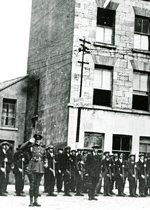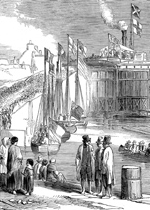Old Galway
George Nicolls (31 03 16)

George Nicolls (Seoirse MacNiocall) was born in Dublin but his professional career brought him to Galway town, where he worked as a solicitor and Coroner for the West Riding District of the County. A committed nationalist, he became involved with Sinn Féin in 1907 and also served as President of the County Board of the GAA. Nicolls was the IRB Centre for Galway town. On 31 November 1913, he presided over a meeting in the Town Hall, for the purpose of formally establishing the Irish Volunteers in the county, and subsequently chaired the ‘monster public meeting’ in the Town Hall on 10 December, at which 600 individuals signed up for the Volunteers.
The Galway Volunteers (24 03 16)

Just a few weeks after the Irish Volunteers were formed in Dublin, a meeting was set up in the Town Hall on December 12th, 1913 to establish a Volunteer force in Galway. There was a lot of excitement and expectation as Eoin McNeill, Roger Casement and Pádraic Pearse told the packed hall that their main objective was to win Home Rule but the movement was also formed to protect them from the Ulster Volunteers. The meeting, which was chaired by George Nicholls, was a major success and some 600 men joined up that evening.
St. Patrick's Day Parade 1916 (16 03 16)

This parade started from the Square in the following order:- Eyre Square North – Industrial School Band; Galway Urban District Council; Galway Board of Guardians; Students of UCG; A.O.H. Eyre Square East – The Monastery School Fife and Drum Band; U.I.L.; Town Tenant’s League; Galway Woolen Manufacturing Co., and the Irish National Foresters.
The Eglinton Canal (10 03 2016)

168 years ago this week, on the 8th of March, work started on the cutting of what we know as the Eglinton Canal. There had been previous attempts to open a passage from the river to the sea. As far back as 1498, the then mayor had a plan to connect the Sandy River with Lough Athalia. It was Alexander Nimmo who first mooted the idea of a canal in 1822. If steamboats could travel from the docks to the Corrib, it would greatly enhance the commercial importance of the city and a valuable connection with the hinterland would be established. His original plan was that this connection would start at the top of Woodquay, where McSwiggans is today, go along Eglinton Street and down the west side of Eyre Square to the docks. The cost proved to be prohibitive and there were a lot of objections from people who owned land or a business along the route.
Republican Prisoners in the Town Hall (03 03 16)

This remarkable photograph was taken in 1920/21. It shows a group of republican prisoners who are being held in the Town Hall. They are surrounded by barbed wire and are being carefully watched by a soldier whom you can see standing beside the tin hut. He is wearing a ‘Brodie’ helmet which was a steel combat helmet invented by Englishman John Brodie during the First World War. There were probably more soldiers on duty inside the hut watching the detainees, the photographer and anyone else who might have been was passing. A notice on one of the windows reads “No one is allowed within ten yards of this building”.
Nineteenth Century Galway Elections (25 02 16)

Elections in the nineteenth century were a great deal more lively, entertaining and violent than those of the present day.
In 1826, Humanity Dick Martin ran in an election against James Lambert. Martin was anxious to win because as a Member of Parliament, he could not be pursued by his numerous creditors. There was a lot of violence between rival factions, major riots, houses burned, many injured and at least one man being killed. Martin won by a landslide, but a Parliamentary enquiry found fraud on a massive scale, and also that the local authorities did nothing to quell the rioting, so Lambert was declared elected.
Seamus Carter, Athlete, Gaeilgóir, Patriot (18 02 16)

Seamus Carter was a fluent Irish speaker who was a member of the Gaelic League since its inception. He was the secretary of the Oireachtas when it was held in Galway in 1913, the famous photograph of which hangs in the Town Hall.
He was a noted athlete in his young days, a prominent member of the Galway City Harriers. He was an avid reader and was regarded as a brilliant conversationalist whose stories were often laced with humour. He started work as a teacher in Galway, but then joined the County Council where he worked in the Courthouse for over 30 years, ending up in charge of the expenditure branch. He lived in Shantalla, with his wife, four sons and a daughter.
The Proclamation of King George V (11 02 16)

“The accession of His Majesty King George V was proclaimed in Galway at 2 o’clock on Saturday (21st of May, 1910). The ceremony was performed by the High Sherriff, Mr. Cecil R. Henry, and took place opposite the Courthouse. On the steps of the building there was a fashionable gathering. Outside the hollow square formed by soldiers and police, the crowd was one of immense proportions. About one hundred men of the Connaught Rangers, with their band and the King’s colour, under Major Sarsfield, were formed up in line opposite the Courthouse, and an equal number of the Royal Irish Constabulary, drawn from Galway and outside stations, filled up the remaining sides of the square. They were in charge of Co. Inspector Flower, Districts-Inspectors Mercer and O’Rorke.
.png)